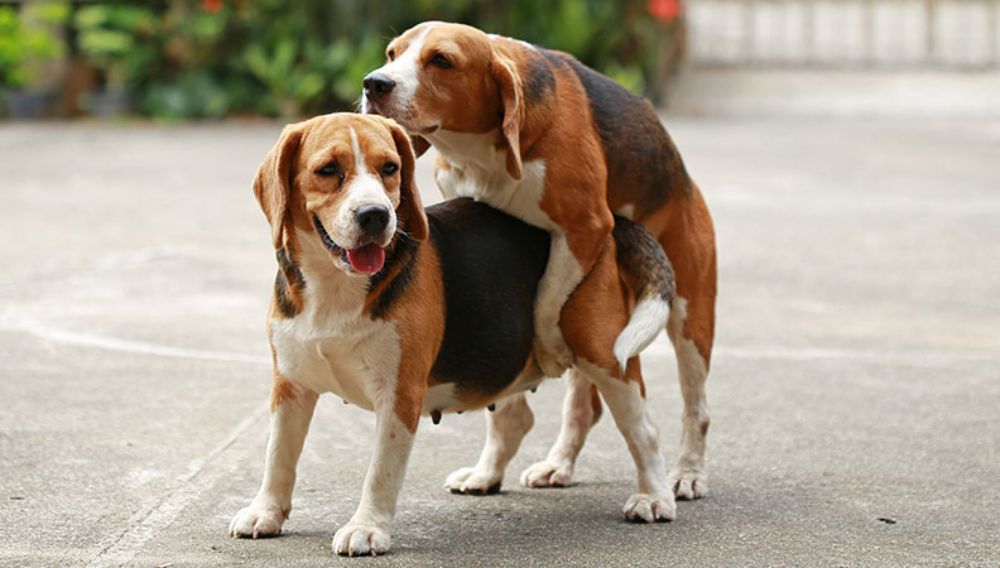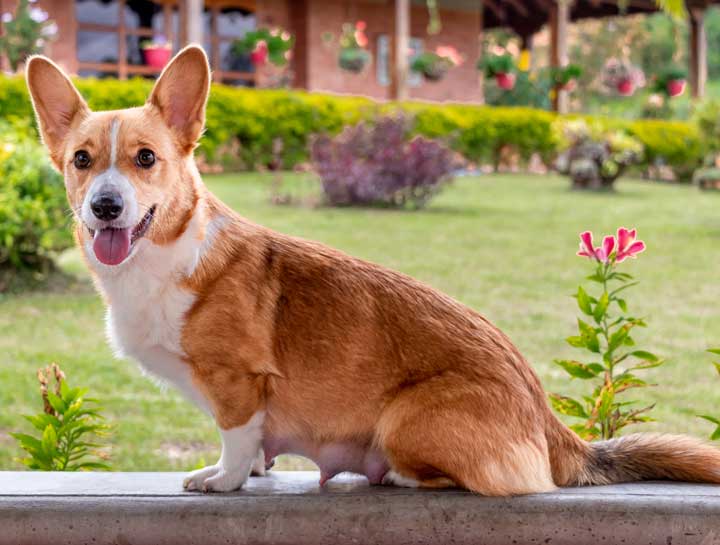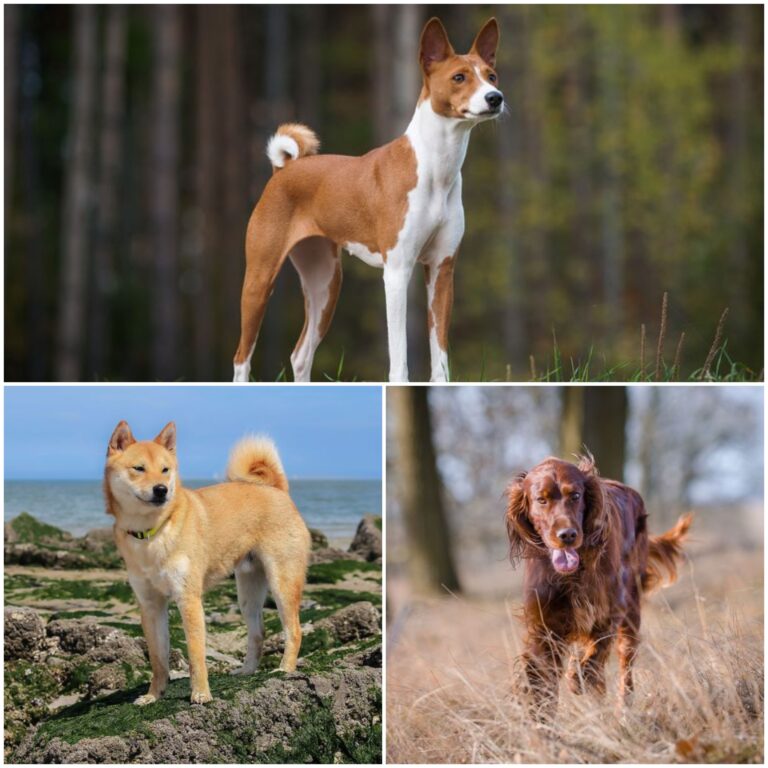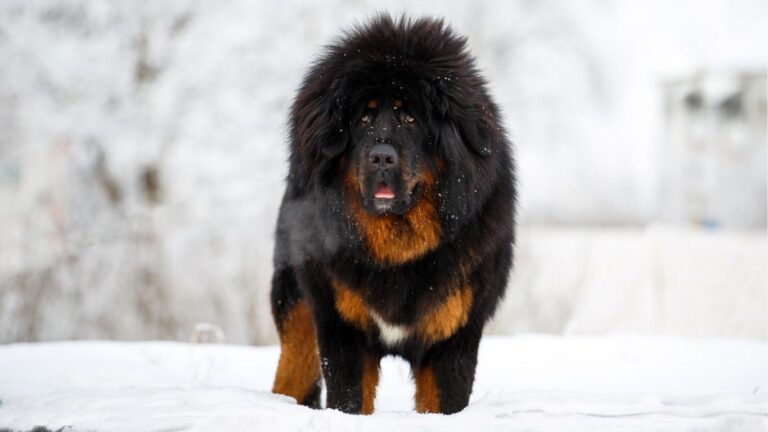How Often Do Dogs Reproduce: Expert Explanation
Last Updated on May 14, 2024 by Petpalace54
Female dogs could have 2 to 3 litters a year during their entire adult life. The timeframe for a female dog to become pregnant again after giving birth can vary from as quickly as 6 to 12 weeks. Hence, responsible breeders will typically breed female dogs no more than once a year & ensure they have enough time to raise their puppies properly. It’s important to prioritize the mother’s quality of life and avoid having her pregnant all the time.
Breeding dogs is a complex process that should be done with care and attention. Knowing how often do dogs reproduce is essential for dog breeders and pet owners to understand the optimal time to breed their dogs. In addition, dog owners also need to learn how to care for their dogs during their heat cycle and the gestation period to ensure the best possible outcome for both the mother and her puppies. We discuss the frequency of dog reproduction, breeding best practices, and answer some of the most common questions about dog reproduction.
Table of Contents
Basics Of How Often Do Dogs Reproduce
Female dogs can go into heat twice a year, but the exact timing can vary. It is important for breeders to carefully track and manage each heat cycle, as breeding should only occur once per year to ensure a healthy & happy mother and puppies.
Now, it’s important to understand the Dog Reproduction Basics to ensure the optimal care of your pet. In this section, we discuss the frequency of heat cycles, signs of heat, the length of the heat cycle, stages of the heat cycle including the Estrus stage, when to breed, and whelping. Understanding these basics is crucial for any dog owner or breeder.
Frequency Of Heat Cycles
Most dogs go into heat twice a year, but some dogs may go into estrus more or fewer times per year, depending on the breed, age, & overall health. Small dogs, such as Chihuahuas, may reach sexual maturity as early as six months of age and go into heat twice a year. In contrast, larger breeds such as Great Danes may not go into heat until they are 18 months or older. Female dogs generally remain in heat for 2-4 weeks, but this can vary depending on the individual.
Signs Of Heat
As a pet owner, it is essential to identify the signs of heat to ensure you provide appropriate care. Some signs of being in heat may include a swollen vulva, frequent urination, a change in behavior, and a bloody discharge. It is essential to note that not all dogs exhibit the same signs, & some dogs may not show any symptoms at all. Thus, it is crucial to keep a close eye on your pet to identify any abnormalities.
Length Of The Heat Cycle
The length of the heat cycle varies, but it typically lasts an average of 21 days. It begins with the proestrus phase characterized by a bloody discharge from the vulva and swelling. During the estrus phase, the discharge may become light pink and watery, and this is considered the peak fertile stage. The final stage is the diestrus phase, where the discharge starts to reduce, and the vulva returns to its normal size.
Stages Of The Heat Cycle
The heat cycle has four stages, including the proestrus, estrus, diestrus, and anestrus stage. The anestrus stage is the period when the dog’s body is inactive and does not show any signs of fertility. In contrast, the other three stages contribute to the dog’s ability to conceive. During this cycle, the female dog’s eggs are released, & mating can occur.
Estrus Stage
The Estrus stage, also known as the fertility stage, occurs around days ten to twelve, & this is the optimal time to breed. During this stage, the female dog is most receptive to males, providing the highest chance of conception. Mating during this period increases the likelihood of producing healthy offspring.
When To Breed
Knowing when to breed is essential for dog breeders and owners. The optimal period to breed is around days ten to twelve of the Estrus stage. However, it is crucial to consider the dog’s health, age, and breed before breeding. Responsible breeders will ensure that female dogs are bred no more than once per year & typically breed no more than two to three litters per year to raise them properly.
Whelping
Whelping is the act of giving birth and requires optimal care to ensure the mother and puppies’ safety. It is recommended to create a whelping box for the mother & her puppies to ensure they are warm, safe, and contained. The optimal time for whelping occurs around 63 days from the day of mating. Before the due date, it is recommended to prepare adequately by having enough supplies such as blankets, towels, and a birthing kit.
In conclusion, the Dog Reproduction Basics are critical for dog breeders and owners to ensure optimal care for their pets. Understanding the frequency of heat cycles, signs of heat, length of the heat cycle, stages of the heat cycle, estrus stage, when to breed, & whelping will enable you to provide the best care for your pet. It is essential to consult with a veterinarian for professional advice on dog breeding.

Credit: www.everypaw.com
Limiting Breeding Frequency
Limiting breeding frequency in dogs is essential to maintain their overall health and well-being. Most dogs come into heat twice a year, but it’s recommended to breed them no more than once a year and not more than two or three litters per year for responsible and ethical breeding practices.
Proper care and record-keeping during the heat cycle are necessary for successful breeding.
Recommended Breeding Frequency
As a responsible dog owner, you should consider limiting breeding frequency to ensure the wellbeing of the mother dog. It’s recommended that female dogs are bred no more than once a year, & that they have at least one heat cycle between litters to allow their bodies to rest. Breeding your female dog too often can result in health problems that could affect future litters.
Risks Of Overbreeding
Overbreeding can cause serious health problems for your female dog, and it can also impact the health of her offspring. If your female dog is bred too frequently, she may suffer from pregnancy-related complications such as pyometra, which is a potentially life-threatening bacterial infection of the uterus. Overbreeding can also lead to reduced fertility & an increased risk of complications during the birthing process.
Commercial Breeding
Breeding dogs for commercial purposes can lead to overbreeding and can result in poor living conditions for the dogs. Commercial breeders may prioritize profit over the health and welfare of the dogs, and may not limit breeding frequency or provide adequate healthcare for their breeding dogs. It’s important to work with reputable breeders who prioritize the health & wellbeing of their dogs.
Giving Mothers Time To Rest
Breeding your female dog too often can lead to physical and emotional stress. It’s important to give your dog time to rest and recover between litters, to ensure her continued health and wellbeing. This means limiting breeding frequency and giving your female dog time to recuperate after a pregnancy. Providing proper care & nutrition to your breeding dog can help ensure her reproductive health and reduce the risk of complications during pregnancy and birth.
In conclusion, limiting breeding frequency is essential for the health and welfare of your female dog. Overbreeding can lead to serious health complications, for both the mother dog and her offspring. As a responsible dog owner, it’s important to prioritize your dog’s health and well-being & work with reputable breeders who share this same commitment.
Factors Affecting Breeding Frequency
The breeding frequency of dogs is affected by various factors such as breed, age, overall health, and environment. Most dogs come into heat twice a year, and should only be bred once each season to ensure their well-being and proper care.
It is important to keep records of each cycle and follow best practices for dog breeding.
Factors Affecting Breeding Frequency
As a pet owner, it’s essential to understand the factors that can affect your dog’s breeding frequency. Breeding too often can be detrimental to your dog’s overall health and wellbeing. Here are some factors that you should be aware of:
Individual Health
Your dog’s individual health plays a vital role in how often they can breed. Dogs with underlying health conditions or genetic predispositions should not be bred regularly. It’s crucial to consult with a veterinarian before breeding your dog. They can guide you on whether your dog is fit to breed & any precautions to take.
Nursing Behavior
If your dog is nursing puppies, they should not be bred. Nursing requires a lot of energy and nutrition from your dog. Breeding while nursing can lead to inadequate milk production, malnutrition, & other health complications.
Breed
The breed of your dog can also affect their breeding frequency. Some breeds have higher fertility rates than others. Additionally, some breeds may be more prone to genetic disorders that can affect their long-term health & breeding ability.
Genetic Diversity
Breeding dogs too often within the same family line can lead to genetic issues in the offspring. Genetic diversity is crucial to maintain a healthy and thriving breed. It’s essential to consider the genetic makeup of both the sire and dam & find compatible mates from outside the family line.
In conclusion, understanding the factors that can affect your dog’s breeding frequency is crucial for their overall health and wellbeing. Consult with your veterinarian to ensure your dog is healthy and ready for breeding, & consider genetic diversity when choosing a suitable mate. By breeding responsibly, you can help maintain a healthy and thriving breed.
Postpartum Breeding
Female dogs go into heat, or estrus, approximately twice a year. Responsible breeders typically breed female dogs no more than once per year, with a maximum of two to three litters per year. It’s important to give female dogs enough time to recover and properly care for their puppies.
Postpartum breeding is the process of breeding dogs after giving birth. It is important to consider the ideal timing for postpartum breeding, as breeding too soon or too frequently can have negative effects on their health. In this section, we will discuss 2 important aspects of postpartum breeding: how quickly can a dog get pregnant again & the ideal breeding schedule after giving birth. Additionally, we will explore the importance of limiting C-sections in dogs.
1. How Quickly Can A Dog Get Pregnant Again
The timeframe for a dog to become pregnant again after giving birth can vary significantly from one dog to another. It can depend on various factors such as breed, individual health, and nursing behavior. In general, most dogs will go into heat (estrus) again approximately six to twelve weeks after giving birth. However, it’s important to wait until the mother dog has fully recovered from the previous birth before attempting to breed again. This will ensure the health of both the mother and the offspring.
2. Ideal Breeding Schedule After Giving Birth
Responsible breeders typically ensure that female dogs are not bred more than once per year. Specifically, they breed no more than two or three litters per year to ensure that there is enough time to take care of them properly. Breeding too frequently can lead to stress and poor health for both the mother and her puppies. New mothers require a lot of care, including proper nutrition & monitoring of their behavior. After giving birth, a female dog needs a break from breeding to rejuvenate and regain her strength.
3. Limiting C-sections
C-section or cesarean section is a surgical procedure carried out when there are complications during the delivery process. While C-sections can be lifesaving for both the mother’s and puppies’ health, it’s important to limit their usage. Too many C-sections can have long-term impacts on the mother’s health and weaken her uterus’s muscles, making vaginal births more difficult in the future. Breeders should carefully monitor their dog’s health and follow a breeding schedule that reduces the need for C-sections.
In conclusion, postpartum breeding is an important topic that every dog owner and breeder must consider. To ensure the mother’s and puppies’ health, it’s crucial to avoid breeding too soon or too often after giving birth. Additionally, limiting the use of C-sections can help protect the mother’s long-term health.
Choosing The Right Breeder
Female dogs go into heat twice a year, but it may vary from dog to dog. Responsible breeders will ensure that female dogs are bred no more than once per year and no more than two to three litters per year to dedicate enough time to raising the puppies correctly.
It’s essential to choose the right breeder to ensure the health and well-being of the mother and puppies.
Choosing the Right Breeder
If you’re considering breeding your dog or getting a new puppy, choosing the right breeder is crucial. A reputable breeder will ensure that their dogs are healthy, happy, & have the best possible start in life. Finding a reputable breeder can be challenging, but it’s worth the effort to ensure that you’re getting a healthy puppy and supporting responsible breeding practices. In this section, we’ll discuss the importance of finding a reputable breeder and provide tips for finding one.
Reputable Breeders
Responsible breeders are committed to breeding healthy, well-socialized puppies. They prioritize the health and wellbeing of their dogs and ensure that their puppies are raised in a loving, safe environment. They also make sure that their puppies are placed in appropriate homes with loving families who will care for them throughout their lives.
Tips for Finding a Reputable Breeder
Finding a reputable breeder can be challenging, but there are a few things you can do to ensure that you’re working with a responsible breeder. Here are some tips to help you find a reputable breeder:
1. Do your research: Start by researching breeds that interest you and look for reputable breeders who specialize in those breeds.
2. Ask for referrals: Ask your vet or other dog owners for referrals to reputable breeders.
3. Check with breed organizations: Check with breed organizations to find reputable breeders who adhere to breed standards & health guidelines.
4. Visit the breeder: Visit the breeder’s facility and meet their dogs in person to assess their living conditions & temperament.
5. Ask questions: Ask the breeder questions about their breeding practices, including health testing, socialization, & temperament.
Why Responsible Breeding is Important
Responsible breeding is essential to ensure the health and wellbeing of dogs. Reputable breeders prioritize health testing, socialization, & proper care when breeding their dogs. They also ensure that their puppies are placed in appropriate homes with loving families who will care for them throughout their lives. By supporting responsible breeding practices, you’re helping to ensure a bright future for dogs and their offspring.
Choosing a Vet for Reproductive Health
Choosing the right vet for reproductive health is critical for ensuring that your dog remains healthy before, during, and after pregnancy. Look for a vet who specializes in reproductive health and has experience working with breeding dogs. They should have a thorough understanding of canine reproductive health and be able to provide you with the guidance & support you need to ensure a successful breeding experience.
:max_bytes(150000):strip_icc()/why-do-dogs-get-stuck-together-when-they-mate-afc2441c960141d785240a85ccd7e547.png)
Credit: www.dailypaws.com

Credit: www.akc.org
Frequently Asked Questions On How Often Do Dogs Reproduce
How Many Times A Year Is A Dog Pregnant?
Biologically, a female dog can have two to three litters a year throughout adulthood, but responsible breeders will only breed female dogs once a year. However, having too many puppies can affect the mother’s quality of life as she will be pregnant all the time.
The timeframe for a dog to become pregnant again after giving birth varies from six to twelve weeks depending on breed, individual health, and nursing behavior. Dogs come into season twice a year on average, but it can vary between breeds.
How Quickly Can A Dog Get Pregnant Again?
Most dogs will go into heat again approximately six to twelve weeks after giving birth, but this can vary. Factors such as breed, individual health, & nursing behavior can affect how quickly a dog can get pregnant again. Responsible breeders ensure female dogs are bred no more than once per year and no more than two to three litters per year.
Generally, a female dog could have two to three litters a year for her entire adult life, but it’s important to prioritize the quality of life of the mother.
How Many Times Can A Dog Breed A Year?
A female dog can have two to three litters per year throughout her adult life. However, responsible breeders will breed their dogs at most once a year and typically only have two to three litters per year. Any more than that is considered puppy farming.
Dogs come into heat twice a year on average, though it varies between breeds. The interval between heat cycles is four to twelve months with an average of seven months. After giving birth, most dogs will go into heat again six to twelve weeks later.
How Often Do Dogs Try To Mate?
Most dogs come into season twice a year, but it may vary from one dog to another. It’s recommended to let a dog have a few seasons before breeding to track her heat cycles and determine when her next season is likely to occur.
Conclusion
To sum up, Expert Explanation of How Often Do Dogs Reproduce, the frequency of dog reproduction depends on several factors, including breed, individual health, and nursing behavior. While a female dog could have two to three litters a year throughout her adult life, responsible breeders usually breed their dogs no more than once per year, & typically with no more than two or three litters per year, to ensure that they have enough time to raise them properly.
It’s essential to keep track of the dog’s heat cycle and calculate the next season’s likelihood accurately. Ultimately, proper care and attention to a female dog’s reproductive & overall health are crucial for successful breeding.







